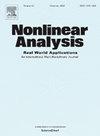探索捕食者-猎物动力学:整合竞争对手捕食者,利用改进的Beddington-DeAngelis功能反应收集猎物的延迟和恐惧效应
IF 1.8
3区 数学
Q1 MATHEMATICS, APPLIED
引用次数: 0
摘要
选择性捕捞是控制过度捕捞和保护幼鱼意外死亡的重要策略。为了确保个体在采收前达到合适的年龄或大小,应保持特定的时间延迟,称为采收诱导延迟。此外,捕食者可以通过引起猎物的恐惧来间接减缓猎物的生长速度,从而影响它们的行为和繁殖。在这项工作中,我们研究了一个捕食者-猎物模型,以检查在被捕食物种存在恐惧的情况下捕食者选择性(延迟)收获的影响以及捕食者与竞争捕食者的种间竞争。假设竞争性捕食者的密度是恒定的,并且两种捕食者都会引起猎物的恐惧。我们通过Hopf分岔确定了非延迟情况和各种延迟诱导情形的跨临界分岔和Hopf分岔存在的相关条件。我们还通过在双参数平面上同时改变收获努力、恐惧水平和与竞争捕食者的种间竞争,数值探讨了延迟收获对系统动力学的影响。观察到,在不同的参数条件下,收获延迟会导致稳定不变性、不稳定性不变性、稳定性变化、不稳定性切换和稳定切换现象。此外,当收获延迟一定时,平衡点在收获努力、种间竞争和恐惧水平方面分别经历不稳定不变和不稳定变化、不稳定变化和不稳定切换,以及不稳定不变、稳定变化和稳定切换。研究结果表明,对捕食者的选择性捕获、对猎物的适度恐惧以及与竞争捕食者的种间竞争对维持生态系统的稳定和共存至关重要。从生物学的角度来看,这种丰富而复杂的动态具有重要意义,并可能对种群管理策略产生潜在影响。本文章由计算机程序翻译,如有差异,请以英文原文为准。
Exploring predator–prey dynamics: Integrating competitor predators, harvesting delay and fear effect on prey with a modified Beddington–DeAngelis functional response
Selective harvesting is a vital strategy for controlling over-exploitation and protecting the incidental killing of juvenile species. To ensure that the individuals reach a suitable age or size before being harvested, a specific time delay, known as harvesting-induced delay, should be maintained. Also, predators can indirectly slow down the growth rate of prey by inducing fear in them, which affects their behaviour and reproduction. In this work, we study a predator–prey model to examine the impact of predator selective (delayed) harvesting in the presence of fear in prey species and the interspecific competition of predator with the competitive predator. It is assumed that the density of the competitive predator is constant and both predators induce fear in prey. We determine the conditions related to the existence of transcritical and Hopf bifurcations for the non-delay case, and various delay-induced scenarios via Hopf bifurcation. We also numerically explore the impact of delayed harvesting on the system dynamics by simultaneously varying the harvesting effort, fear level, and the interspecific competition with competitive predator in bi-parametric planes. It is observed that the harvesting delay can result in stability invariance, instability invariance, stability change, instability switching, and stability switching phenomena under varied parametric conditions. Further, when the harvesting delay is fixed, the equilibrium point experiences instability invariance and instability change, instability change and instability switching, and instability invariance, stability change and stability switching with respect to the harvesting effort, the interspecific competition, and the fear level, respectively. Our findings indicate that regulated selective harvesting of predator, and a moderate level of fear in prey and interspecific competition with the competitive predator are essential for maintaining stability and coexistence in the ecosystem. The rich and complex dynamics holds significance from a biological viewpoint and may potentially impact the population management strategies.
求助全文
通过发布文献求助,成功后即可免费获取论文全文。
去求助
来源期刊
CiteScore
3.80
自引率
5.00%
发文量
176
审稿时长
59 days
期刊介绍:
Nonlinear Analysis: Real World Applications welcomes all research articles of the highest quality with special emphasis on applying techniques of nonlinear analysis to model and to treat nonlinear phenomena with which nature confronts us. Coverage of applications includes any branch of science and technology such as solid and fluid mechanics, material science, mathematical biology and chemistry, control theory, and inverse problems.
The aim of Nonlinear Analysis: Real World Applications is to publish articles which are predominantly devoted to employing methods and techniques from analysis, including partial differential equations, functional analysis, dynamical systems and evolution equations, calculus of variations, and bifurcations theory.

 求助内容:
求助内容: 应助结果提醒方式:
应助结果提醒方式:


